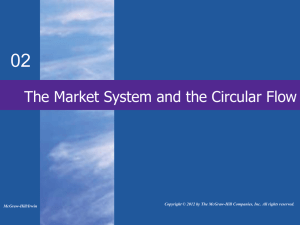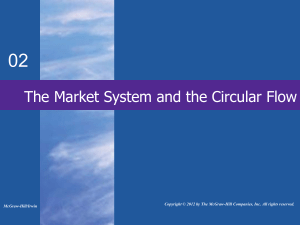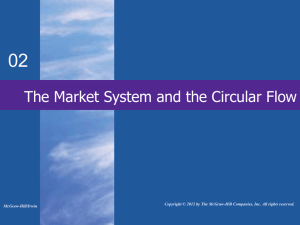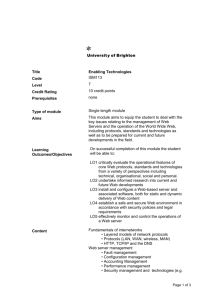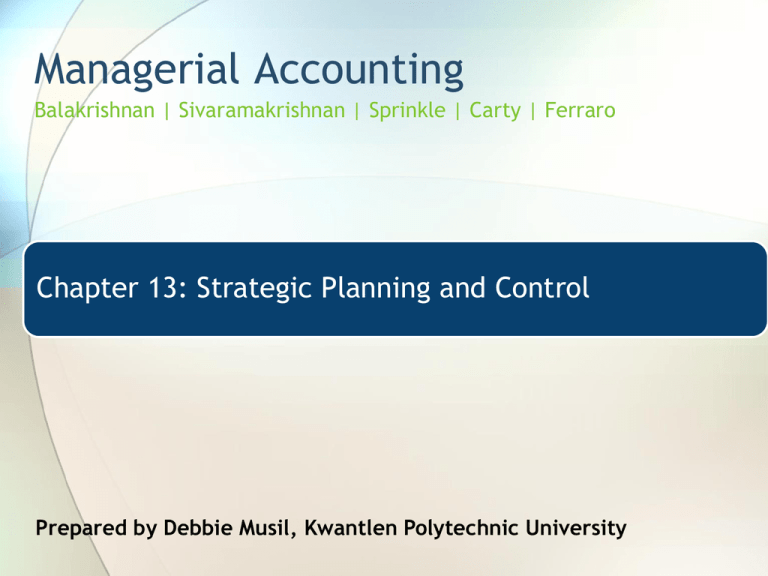
Managerial Accounting
Balakrishnan | Sivaramakrishnan | Sprinkle | Carty | Ferraro
Chapter 13: Strategic Planning and Control
Prepared by Debbie Musil, Kwantlen Polytechnic University
Determinants of Strategy
• Strategy is the approach for creating and
sustaining a value proposition, the source of
customer’s value
• Some factors that influence business strategy
are:
− Core competency
− Competitive landscape
− Sustainability
LO1: Explain the role of management ... guiding strategy
Core Competency
• Skill set and expertise that characterizes a firm and its
employees, and advantages the firm relative to its
competitors
− Lucent, Wal-Mart, Nike
• A successful business strategy builds organizational
capabilities around the core competencies of its
founders, key employees, or the processes it has
developed over time.
− Core competencies guide the value propositions of
a firm
− A strategy not anchored firmly in core
competencies is destined to fail
LO1: Explain the role of management ... guiding strategy
Competitive Landscape
LO1: Explain the role of management ... guiding strategy
Sustainability
• New and existing competitors will emulate the
business strategies of successful firms
• A sustainable strategy is difficult to imitate by
competitors
− Relies on unique resource capabilities and market
power it brings.
• Sears versus Wal-Mart
• United versus Southwest Airlines
• Successful firms adopt innovative strategies
LO1: Explain the role of management ... guiding strategy
Type of Business Strategies
LO1: Explain the role of management ... guiding strategy
Strategy Dictates Information
Needs
LO1: Explain the role of management ... guiding strategy
Building a Value Chain
• Value Chain:
− Set of logically sequenced, value-adding
activities
− Convert inputs into products or services
− Consistent with chosen business strategy
• A crucial step in successfully
implementing a business strategy
− An activity that adds value under one
strategy may diminish value under another
LO2: Understand the value chain for a business
The Value Chain
LO2: Understand the value chain for a business
Extending Beyond The Firm
• We also need to consider the value chain links
outside of the firm
− Entire value chain starts from natural raw materials
(e.g., ore) to final disposition of product by end user
(e.g., landfill)
• Role of suppliers
− Can provide scale economies
− Expertise
• Role of partners
− Can help with scope economies
− Strategic positioning of business to leverage core
competency
LO2: Understand the value chain for a business
Value Chain: Example
LO2: Understand the value chain for a business
Configuring A Value Chain
LO2: Understand the value chain for a business
Strategic Cost Planning
• Two techniques to help firm make long-term
product planning decisions
− Life-cycle analysis
− Target costing
• Life Cycle of a product
− All products go through five stages
− However, cycles of different products can vary
considerably
• Determining life cycles helps firm determine
the rate at which new products must be
developed
LO3: Appreciate product life cycle analysis and target costing
Stages In Product Life Cycle
LO3: Appreciate product life cycle analysis and target costing
Activities and Profit Profiles
LO3: Appreciate product life cycle analysis and target costing
Target Costing
• Structured approach to cost planning and
management
• Assumes that firm is a price taker
− Knowledgeable consumers, intense competition
• Onus on firm to make products at less than the
implied (target cost)
Allowable cost = Price point – desired profit margin
• Price (equivalently, revenue) is calculated over
the entire product lifecycle
LO3: Appreciate product life cycle analysis and target costing
Design Influences Costs
LO3: Appreciate product life cycle analysis and target costing
How To Perform Target Costing
• Compute allowable cost
− Examine customer value for proposed product to
determine price point
− Management dictates profit margin (as % of sales)
− Calculate allowable cost
• Compute cost gap
− Determine current cost for making the product
− Cost gap = Current cost – allowable cost > 0
• Manage cost
− Rework design /features to eliminate cost gap
LO3: Appreciate product life cycle analysis and target costing
Effectiveness Of Target Costing
• Industries where competition limits a firm’s ability to
obtain a substantial and sustainable premium for
innovations
− Less useful where products are well differentiated
• Product can be described well in terms of (separable)
features
− Less effective for commodity type products
• Effectiveness of practice depends a great deal on
− Use of cross-functional teams
− Detailed understanding of the market and customer
value
− Insight into cost information to make the right
tradeoffs among price, quality and functionality
LO3: Appreciate product life cycle analysis and target costing
Implementing Strategy
• We often employ lagging indicators of
performance
− They tell us a lot about how we did in the past. Less
about how we are likely to do in the future
− ROI, RI and EVA are all lagging measures
• We also need leading indicators
− Inform us about drivers of future performance
− Customer satisfaction, employee morale, defect
rates all tell us if we have the foundations for profit
tomorrow.
− Order backlog (a financial number) can be a leading
indicator
LO4: Discuss the need for multiple performance measures
Financial Vs. Non-financial Measures
• Financial measures are often lagging indicators
− They are too aggregate
− Do not provide timely information for proactive
corrections
− Are not specific about required actions
• But,
− Financial measures help keep the eye on the “final
ball”
− Lets a firm tradeoff (choose among) competing
priorities
• Firms therefore use financial measures but supplement
them with non-financial measures
− Like a pilot, need to monitor many items at the
same time
LO4: Discuss the need for multiple performance measures
Need For Multiple Measures
LO4: Discuss the need for multiple performance measures
Critical Success Factors
• Measures of processes that the firm MUST get
right for it build and maintain competitive
advantage
− Also known as Key Performance Indicators (KPI)
• Strategic CSFs are long-term metrics
− Sales turnover ratios, time between product
generations
− Firm-specific
• Operational CSFs measure short-term
efficiency
− Cost per unit, average outgoing product quality
LO4: Discuss the need for multiple performance measures
Properties of CSFs
• We can identify many items to monitor for a
firm
• Have to pick a select few that are critical
• Ideal properties include:
−
−
−
−
Simple and easy to understand
Readily quantifiable
Easy to monitor
Linked to strategy (perhaps most important)
LO4: Discuss the need for multiple performance measures
CSFs Depend On Business Strategy
LO4: Discuss the need for multiple performance measures
Y
N
N
Y
Y
Y
N
Y
Y
Y
Y
Y
LO4: Discuss the need for multiple performance measures
Balanced Scorecard
• Performance measurement system that
includes a systematic approach for linking
strategy to planning and control
• The approach
− Guides the choice of which CSFs to monitor
− Allows a firm to communicate strategy
− Permits employees to see links among performance
dimensions
LO5: Describe a balanced scorecard
Need For “Balancing” Measures
LO5: Describe a balanced scorecard
Four Perspectives Of The BSC
LO5: Describe a balanced scorecard
The Four Perspectives
• Financial
− ROE, Market value added, EVA
− Ultimate goal for most for-profit organizations
• Customer
− Customer satisfaction, complaint rates, churn rate
− Source of profit
• Internal process
− Cycle time, efficiencies, development time
− Effectiveness and efficiency of internal processes that
generate and deliver the value proposition – the source of
customer value
• Innovation and Learning
− Assure survival for the future – monitor and manage
strategic risk
LO5: Describe a balanced scorecard
BSC for ClientSys
LO5: Describe a balanced scorecard
Appendix: Target Costing
Appendix
Target Costing (Cont’d)
Appendix
Exercise 13.29
Value proposition in same industry (LO1).
Firms in the same industry offering the same end-product may
offer different value propositions. For instance, consumers can
obtain an airline ticket directly from the airline, a travel agent, or
a travel Web site. Similarly, we can obtain clothing from a
department store such as The Bay, a “clothing only” store such
as Jacob, or a designer firm such as Gucci.
Required:
a) Compare and contrast the value propositions offered by a
travel site such as Expedia or Travelocity with that offered
by a travel agent.
b) How does this insight translate to other services such as
stock trading?
Exercise 13.29 (Continued)
a) Compare and contrast the value propositions offered by
a travel site such as Expedia or Travelocity with that
offered by a travel agent.
While the end product is the same, the bundle of features offered
differs greatly between travel websites and travel agents. The
former assumes considerable knowledge on the part of the traveler
and offers a way to quickly compare multiple fares. The aim is to
provide a great deal of information and cheap fares. But, the
responsibility is on you to understand the information being
provided.
Exercise 13.29 (Continued)
a) Compare and contrast the value propositions offered by
a travel site such as Expedia or Travelocity with that
offered by a travel agent.
A travel agent provides considerably more hand-holding. The agent
may well advise the traveler on alternate modes of transportation,
the best way to change currency, how to find a package deal, and so
on. The agent might even help with choice of a destination (e.g., for
a vacation).
The value proposition is therefore not low cost but access to a
wealth of travel information.
(Of course, the traveler has to pay for this information in the form of
the travel agent’s commission from ticket and other sales.)
Exercise 13.29 (Concluded)
b) How does this insight translate to other services such as
stock trading?
We find a similar tradeoff between discount traders such as
Scottrade or Brown and Company. These services allow you to
trade; they provide lots of information but little advice. In
contrast, a full-service brokerage such as AG Edwards will
completely handle all of the details (beginning with asset
allocation and planning, down to executing individual trades
and providing tax advice). Here, the value proposition is advice
and help rather than cost.
Clearly, the clientele differs for each kind of firm. A person wellversed in finance might choose a discount broker while
persons with little idea about how to handle money might
(implicitly or explicitly) pay a full-service broker to handle the
portfolio on their behalf.
Copyright
Copyright © 2011 John Wiley & Sons Canada, Ltd. All rights reserved.
Reproduction or translation of this work beyond that permitted by
Access Copyright (the Canadian copyright licensing agency) is unlawful.
Requests for further information should be addressed to the
Permissions Department, John Wiley & Sons Canada, Ltd. The purchaser
may make back-up copies for his or her own use only and not for
distribution or resale. The author and the publisher assume no
responsibility for errors, omissions, or damages caused by the use of
these files or programs or from the use of the information contained
herein.

